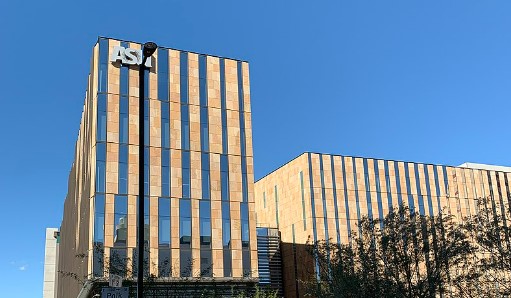
by Corinne Murdock | Aug 15, 2023 | News
By Corinne Murdock |
Arizonans are eligible to receive $1.03 billion in student debt relief, according to the latest estimates from the Biden administration.
Arizona’s cut accounts for about 2.6 percent of the $39 billion issued for 804,000 total borrowers (an average of over $48,500 per borrower). In a press release, the Department of Education (ED) clarified that the billion-odd in funds applied to over 20,500 borrowers in Arizona.
$1.03 billion for 20,500 borrowers averages about $50,200 per borrower: about $2,000 short of four years of in-state tuition at Arizona State University, $2,600 short of four years of in-state tuition at the University of Arizona, and $4,500 more than four years’ tuition at Northern Arizona University.
The relief constitutes the 12th-highest award from the Biden administration. The 11 other states above Arizona, in order from highest to lowest award amount, were: Texas, Florida, California, Georgia, New York, Ohio, Illinois, Michigan, North Carolina, Pennsylvania, and Virginia.
In a statement, President Joe Biden said that the past mistakes of the federal government were to blame for individuals not paying their debts. Biden also said that Republican lawmakers were hypocritical and dismissive for rejecting his sweeping student loan forgiveness.
“I have long said that college should be a ticket to the middle class — not a burden that weighs down on families for decades,” stated Biden.
The federal relief comes from the Income-Driven Repayment (IDR) plans launched by the Biden administration. The IDR plans slash undergraduate loan payments in half and abolish payments for low-income borrowers. The Biden administration determines IDR plans based on discretionary income: the difference between annual income and 150 percent of the poverty guideline based on the borrower’s family size and state of residence.
There are four possible IDR plans: Revised Pay As You Earn Repayment Plan (REPAYE) lasting 20 years for undergraduate loans only or 25 years for any graduate or professional loans, requiring 10 percent of discretionary income; Pay As You Earn Repayment Plan (PAYE) lasting 20 years, requiring 10 percent of discretionary income or a maximum based on the 10-year Standard Repayment Plan amount; Income-Based Repayment Plan (IBR), requiring 10 percent of discretionary income for new borrowers on or after July 1, 2014 and lasting 20 years, or 15 percent of discretionary income for older borrowers on or after July 1, 2014 and lasting 25 years, with both contingencies capped by the 10-year Standard Repayment Plan; and the Income-Contingent Repayment Plan (ICR) lasting 25 years, requiring 20 percent of discretionary income or projected payment on a repayment plan with a 12-year fixed payment adjusted to income.
Even if borrowers don’t fully pay off their loan balance under their IDR plan, the federal government will forgive the remaining loan balance. ED will also count months of nonpayment based on certain criteria toward the total repayment period: economic hardship deferment, repayment under other plans, and required zero amount payment periods. Additionally, ED offers borrowers total forgiveness of any remaining balance after 10 years of payments, rather than 20 or 25 years, should the borrower participate in both an IDR plan and the Public Service Loan Forgiveness (PSLF) Program.
ED began notifying eligible borrowers of the relief earlier this month. The Biden administration has issued over $116 billion in student loan relief for three million borrowers: an average of $38,600 per borrower.
That average is roughly several hundred dollars less than the average national total for four years of in-state tuition at a public college, and about equivalent to the average national total for just over one year of out-of-state tuition at a public college.
Corinne Murdock is a reporter for AZ Free News. Follow her latest on Twitter, or email tips to corinne@azfreenews.com.

by Corinne Murdock | Aug 13, 2023 | News
By Corinne Murdock |
Come February 2024, travelers can book a direct flight from Phoenix to the one of the world’s deadliest cities: Tijuana, Mexico.
Phoenix Sky Harbor Airport announced late last month that American Airlines will begin offering the direct flights to Tijuana.
Phoenix Mayor Kate Gallego hailed the move as an economic boost.
“This new connection will ultimately strengthen our tourism industry, support business, and create more job opportunities for Phoenicians,” said Gallego.
The Citizens Council for Public Security and Criminal Justice, a Mexican organization, reported that Tijuana had the fifth-highest murder rate of 105 for every 100,000 residents in 2022 (there were nearly 2,200 homicides in one year per two million residents). Nine of the ten deadliest cities worldwide were located in Mexico.
In May, the Baja California’s State Attorney General’s Office reported over 600 murders from this January to April.
The one city to make the top-ten ranking that wasn’t located in Mexico was New Orleans, Louisiana at eighth. Baltimore, Maryland ranked 17th; Detroit, Michigan ranked 23rd; Memphis, Tennessee ranked 25th; Cleveland, Ohio ranked 27th; Milwaukee, Wisconsin ranked 39th; and Philadelphia, Pennsylvania ranked 46th.
Located in Tijuana is the New Generation Tijuana Cartel, or Tijuana Cartel, formerly the Arellano-Félix Organization (AFO), allied with the Jalisco New Generation Cartel: one of the two leading cartels responsible for the deadly drug epidemic in the U.S. The other is their rival, the Sinaloa Cartel.
Drug smuggling has become an issue on passenger flights; reports identified American Airlines flights among those used to traffic drugs. In May, the American Airlines mechanic was convicted for drug smuggling.
Customs and Border Protection (CBP) stated in a report last year that cartels have internal conspirators within airlines that assist in smuggling the drugs. Ramon Santaliz, a CBP Aircraft Search Team officer, said he’s seen traffickers posing as all sorts of figures. They store the drugs anywhere imaginable: checked luggage, life vests, bathroom waste tanks, galley carts, garbage cans, toilet paper rolls, aircraft computer cabinets, pilot seats, wing spars, even first class armrests.
“It could be the caterers, cleaners, mechanics, baggage handlers, flight crew, or even the security guards. Money moves a lot of people,” said Santaliz. “The aircraft is its own contained world. [Drugs] could be anywhere on the aircraft — from the tip of the nose all the way to the tail because there are hidden spaces everywhere.”
CBP conducts its drug seizure tactics using a mix of trends and chance. Officers review flight schedules and will “randomly” select flights to search. Airlines pay fines of $1,000 an ounce for any drugs discovered during CBP searches.
Last August, the U.S. Consulate issued a “shelter in place” advisory for Americans residing in Tijuana after dozens of people were killed amid a fight between the Jalisco and Sinaloa Cartels. The advisory succeeded former Gov. Doug Ducey’s executive order to finish the border wall by several hours. The violence prompted the descent of military reinforcements to the area.
In recent months, local cartels have engaged in violent public conflict over control of strip clubs, brothels, and bars within Tijuana’s Zona Norte. One confrontation earlier this month resulted in a deadly shootout, with two dead.
In addition to Tijuana, American Airlines will also offer daily flights to Guadalajara, Mexico.
Corinne Murdock is a reporter for AZ Free News. Follow her latest on Twitter, or email tips to corinne@azfreenews.com.

by Corinne Murdock | Aug 12, 2023 | Education, News
By Corinne Murdock |
Applicants to Arizona State University’s (ASU) law school may have to take their admissions test on their own, but they won’t have to do their own applications.
ASU Sandra Day O’Connor College of Law will now allow applicants to use generative artificial intelligence (AI) to complete their applications. In a press release at the end of last month, the law school stated that generative AI will be a necessary tool for upcoming lawyers.
“In our mission to educate and prepare the next generation of lawyers and leaders, law schools also need to embrace the use of technology such as AI with a comprehensive approach,” stated the school.
Stacy Leeds, Willard H. Pedrick Dean and Regents Professor of Law, added that generative AI also allowed for more equitable admissions.
“Our law school is driven by an innovative mindset. By embracing emerging technologies, and teaching students the ethical responsibilities associated with technology, we will enhance legal education and break down barriers that may exist for prospective students,” said Leeds. “By incorporating generative AI into our curriculum, we prepare students for their future careers across all disciplines.”
Generative AI consists of large language model (LLM) tools: one of the most popular models is ChatGPT.
Last month, two New York lawyers were sanctioned for relying on a ChatGPT-generated brief that cited fake cases. The judge punished the pair for not conducting a proper review of the AI brief and for insisting that the fake cases cited were real, not for relying on generative AI in the first place.
The pair paid $5,000 for their oversight. The lawyers stated that they didn’t know that ChatGPT could create fake cases. However, the lawyers’ firm issued a statement disagreeing that the use of generative AI constituted bad faith.
“We made a good faith mistake in failing to believe that a piece of technology could be making up cases out of whole cloth,” stated the firm.
The New York lawyers may well become a case study at ASU. ASU’s law school also offers courses through its Center for Law, Science, and Innovation (LSI) on the legal questions of AI use, especially within the legal field.
One of LSI’s AI-centered projects, the Soft Law Governance of Artificial Intelligence, proposes using “soft law” governance for AI rather than existing legal frameworks. Soft law is a blanket term for recommendations or guidelines, rather than law. The project is funded by the Charles Koch Foundation.
ASU’s law school began allowing AI-generated applications this month.
Corinne Murdock is a reporter for AZ Free News. Follow her latest on Twitter, or email tips to corinne@azfreenews.com.

by Corinne Murdock | Aug 12, 2023 | News
By Corinne Murdock |
An audit released last month found that the Arizona Department of Child Services (DCS) has failed to follow state law on information sharing and case review attendance for foster children.
The report was the first in a three-part series on DCS, determining whether DCS followed law to provide the information necessary for local foster care review boards to complete foster children’s cases. The auditor general, Lindsey Perry, found that DCS caseworkers failed to provide all the necessary documents for children’s cases, and failed to attend case review meetings.
There are 109 local boards that determine foster cases; these boards rely on the Administrative Office of the Courts (AOC) to relay information from DCS. The auditor general found that DCS consistently failed to provide case documents to the AOC through their automated application, Guardian. The auditor general found that the poor DCS performance not only hindered children’s cases, but diminished trust from the AOC and the local boards.
“[T]he automated information exchange not providing some information to AOC on behalf of local boards has negatively impacted AOC’s and local boards’ trust and confidence in the Department and the Department’s reputation,” stated Perry. “As a result, AOC staff reported that they and local boards may assume that the Department has withheld information that should have been provided, which has negatively impacted AOC’s and local boards’ trust in and working relationship with the Department.”
Local boards require three necessary documents: the court report, which DCS develops for hearings; the case plan, in which DCS outlines the goals and tasks necessary to ensure a child achieves permanency; and the Team Decision Making (TDM) meeting summary, in which DCS summarizes decisions made during meetings about a child’s safety, stability, and permanency.
The auditor general report found that all 13 samples of 124 case reviews conducted by local boards on June 28, 2022, and July 6, 2022 failed to include a complete version of those three necessary documents. That came out to 31 of 39 case documents provided incompletely or not provided at all.
According to the report, AOC staff and local board volunteers experienced difficulty in conducting reviews due to the lack of information about children’s cases.
Part of the information exchange failure resulted from AOC staff failing to submit valid document requests. That mistake resulted in 15 of the 31 missing case documents. The auditor general also found that DCS caseworkers failed to store complete case documents in Guardian in 10 of the 31 faulty or missing case documents. This latter mistake by DCS accounted for some of the AOC staff members’ faulty document requests: AOC failed to obtain the necessary documents because DCS failed to upload into the system.
The auditor general noted that DCS policy doesn’t advise superiors on proper punitive measures.
4 of the 31 missing case documents were due to DCS determining they weren’t necessary and therefore weren’t stored in Guardian — a circumstance which DCS doesn’t communicate to AOC. The remaining 2 missing or inaccessible documents were due to a software issue and a limitation on legal document access, respectively.
The state legislature passed changes to the law through HB2213 requiring DCS to provide AOC direct, remote access to Guardian in addition to any DCS information necessary for local board duties.
DCS attempted to dismiss the significance of their shortcomings in information exchange via Guardian, advising the auditor general that AOC staff may request case documents via other means, such as when emailing reminders to caseworkers about local board reviews, or accessing the Maricopa County Superior Court IT system. However, the auditor general dismissed these alternatives as time-consuming.
“[O]btaining case documents from these alternative sources may require both AOC and Department staff to spend additional and potentially unnecessary time that could be otherwise spent on other mission critical activities,” stated Perry.
Perry advised that DCS should provide all necessary case documents, hold monthly supervision meetings with caseworks to ensure document compliance, revise and implement policies and procedures to require caseworkers to store court reports in Guardian by verification of supervisors, implement guidance for supervisors to handle non-compliant caseworkers, and solicit continued feedback from AOC on their information exchange. DCS agreed to implement the proposed changes.
The auditor general also found that 18 percent of caseworkers on a sample of days failed to follow policy requiring either attendance or having their supervisor attend local board case reviews, and notify AOC if attendance isn’t possible. In two of the 124 case reviews observed in which the caseworker failed to show or provide a case update, the auditor general noted that the local board was unable to determine the status of a child who’d been hospitalized for abuse and a child plagued by mental health and self-harm issues.
The auditor general recommended that DCS ensure caseworkers comply with policy requirements on case review attendance, revise and implement policy to provide case updates, and work with AOC to determine information for updates when caseworkers can’t attend.
Corinne Murdock is a reporter for AZ Free News. Follow her latest on Twitter, or email tips to corinne@azfreenews.com.

by Corinne Murdock | Aug 11, 2023 | News
By Corinne Murdock |
Tucson has received nearly $71.5 million to cover progressive housing and emissions initiatives.
Around $50 million will go into housing, and $21.5 million will go into emissions reduction and elimination.
The city received $50 million out of a total $370 million awarded to eight communities by the Department of Housing and Urban Development (HUD) Choice Neighborhoods Implementation (CNI) initiative.
Tucson received the higher reward of $50 million alongside Birmingham, Alabama; Pittsburgh, Pennsylvania; Philadelphia, Pennsylvania; and Wilmington, Delaware. The remaining three recipients — Atlanta, Georgia; Lake Charles, Louisiana; Miami-Dade County, Florida — received $40 million.
Tucson’s $50 million will only partially cover the 550 new or rehabilitated housing units planned by the city— the city disclosed that it required $334 million more from public, private, and nonprofit benefactors to complete its plan.
408 of the 550 units concern the city’s 17-story public housing facility, Tucson House. The remainder will be established across three new developments.
The 550 units are part of the Transformation Plan of the Thrive in the ‘05 initiative: a 2.3 square mile area marked by Oracle Road and Miracle Mile. Tucson Mayor Regina Romero and the Tucson City Council adopted the plan last year.
HUD CNI is a progression of former President Barack Obama’s original Choice Neighborhoods program. The Obama administration sought to disrupt the consolidation of crime and poverty prevalent in purely public and HUD-assisted housing by engineering mixed-income neighborhoods: a mixture of either market-rate and welfare-discounted housing, or entirely welfare-discounted housing. The program also focuses on establishing other amenities, such as schools and businesses, to improve those areas.
In addition to the CNI, Tucson’s initiative includes the Community Based Crime Reduction (CBCR), an effort to increase reliance on community-based policing led by Nadia Roubicek with the Arizona State University (ASU) Office of Community Health Engagement and Resiliency (OCHER). CBCR was established through the Department of Justice (DOJ) Bureau of Justice Assistance (BJA) Innovation Suite (also called the Smart Suite).
There’s also the Workforce & Economic Development, a partnership with the City of Tucson Economic Initiatives and Pima Community College, which provides employment and business resources and opportunities.
The fourth focus of Thrive in ‘05 — Tucson Community Access, Referral, Education, and Service (CARES) — offers residents medical and behavioral health care liaisons.
In addition to the $50 million for government housing, the city also received nearly $21.5 million from the Department of Transportation’s Federal Transit Administration to decarbonize its Sun Tran transit system. The funding will cover the replacement of the city’s remaining diesel bus fleet with 39 compressed natural gas buses. Their cut comes from a total of nearly $1.7 billion in funding for similar transit emissions reduction or elimination initiatives spanning 46 states.
In addition to the $21.5 million, Tucson contributed nearly $5.4 million to the grant.
Corinne Murdock is a reporter for AZ Free News. Follow her latest on Twitter, or email tips to corinne@azfreenews.com.





